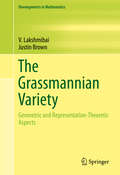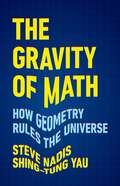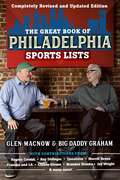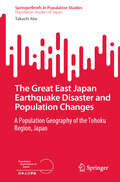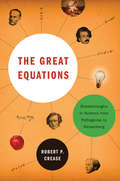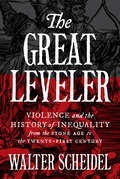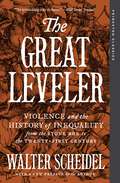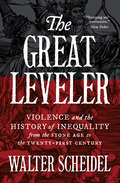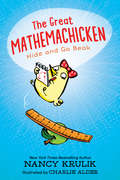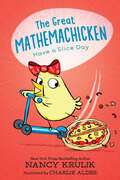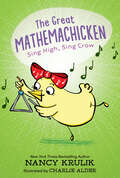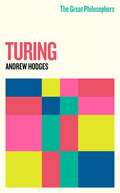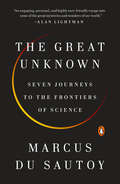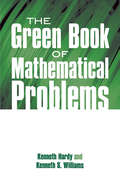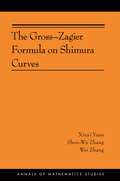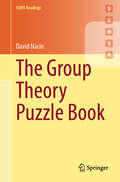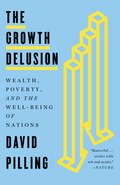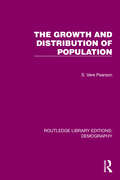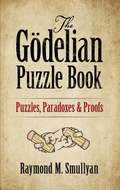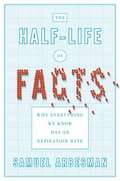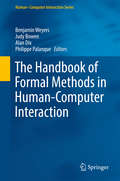- Table View
- List View
The Grapes of Math: Mind-Stretching Math Riddles
by Greg Tang Harry BriggsIllustrated riddles introduce strategies for solving a variety of math problems in using visual clues. Each riddle & the rhyming clues that accompany it, can be answered by applying simple math skills like adding, subtracting, and multiplying.
The Grassmannian Variety
by V. Lakshmibai Justin BrownThis book gives a comprehensive treatment of the Grassmannian varieties and their Schubert subvarieties, focusing on the geometric and representation-theoretic aspects of Grassmannian varieties. Research of Grassmannian varieties is centered at the crossroads of commutative algebra, algebraic geometry, representation theory, and combinatorics. Therefore, this text uniquely presents an exciting playing field for graduate students and researchers in mathematics, physics, and computer science, to expand their knowledge in the field of algebraic geometry. The standard monomial theory (SMT) for the Grassmannian varieties and their Schubert subvarieties are introduced and the text presents some important applications of SMT including the Cohen-Macaulay property, normality, unique factoriality, Gorenstein property, singular loci of Schubert varieties, toric degenerations of Schubert varieties, and the relationship between Schubert varieties and classical invariant theory. This text would serve well as a reference book for a graduate work on Grassmannian varieties and would be an excellent supplementary text for several courses including those in geometry of spherical varieties, Schubert varieties, advanced topics in geometric and differential topology, representation theory of compact and reductive groups, Lie theory, toric varieties, geometric representation theory, and singularity theory. The reader should have some familiarity with commutative algebra and algebraic geometry.
The Gravity of Math: How Geometry Rules the Universe
by Shing-Tung Yau Steve NadisOne of the preeminent mathematicians of the past half century shows how physics and math were combined to give us the theory of gravity and the dizzying array of ideas and insights that has come from it Mathematics is far more than just the language of science. It is a critical underpinning of nature. The famed physicist Albert Einstein demonstrated this in 1915 when he showed that gravity—long considered an attractive force between massive objects—was actually a manifestation of the curvature, or geometry, of space and time. But in making this towering intellectual leap, Einstein needed the help of several mathematicians, including Marcel Grossmann, who introduced him to the geometrical framework upon which his theory rest. In The Gravity of Math, Steve Nadis and Shing-Tung Yau consider how math can drive and sometimes even anticipate discoveries in physics. Examining phenomena like black holes, gravitational waves, and the Big Bang, Nadis and Yau ask: Why do mathematical statements, derived solely from logic, provide the best descriptions of our physical world? The Gravity of Math offers an insightful and compelling look into the power of mathematics—whose reach, like that of gravity, can extend to the edge of the universe.
The Great Book of Philadelphia Sports Lists (Completely Revised and Updated Edition)
by Glen Macnow Big Daddy GrahamWhen it comes to sports talk, no city has more to say than Philadelphia.With their 2007 The Great Book of Philadelphia Sports Lists, WIP sports radio hosts Glen Macnow and Big Daddy Graham compiled dozens of sports lists to stir up dialog and debate within the buzzing Philadelphia sports community (and beyond).A lot has happened in Philly sports since 2007 -- the Phillies' 2008 World Series win; the Eagles' record-breaking 2017 season, now-famous Philly Special play, and Super Bowl LII victory over the Patriots; the Sixers' "Trust the Process" campaign; and, of course, Gritty -- so now Glen and Big Daddy are back with dozens of new lists to keep the conversation fresh, ranking things like:The most overrated and underrated players in Philly sports historyThe top 10 Philadelphia sports quotesThe 10 worst Eagles draft picks everThe greatest duos in Philly sports historyThe 10 best sports movies set in PhiladelphiaThe worst bosses in Philly sports historyand much more!
The Great Demographic Illusion: Majority, Minority, and the Expanding American Mainstream
by Richard AlbaWhy the number of young Americans from mixed families is surging and what this means for the country’s future Americans are under the spell of a distorted and polarizing story about their country’s future―the majority-minority narrative―which contends that inevitable demographic changes will create a society with a majority made up of minorities for the first time in the United States’s history. The Great Demographic Illusion reveals that this narrative obscures a more transformative development: the rising numbers of young Americans from ethno-racially mixed families, consisting of one white and one nonwhite parent. Examining the unprecedented significance of mixed parentage in the twenty-first-century United States, Richard Alba looks at how young Americans with this background will play pivotal roles in the country’s demographic future.Assembling a vast body of evidence, Alba explores where individuals of mixed parentage fit in American society. Most participate in and reshape the mainstream, as seen in their high levels of integration into social milieus that were previously white dominated. Yet, racism is evident in the very different experiences of individuals with black-white heritage. Alba’s portrait squares in key ways with the history of immigrant-group assimilation, and indicates that, once again, mainstream American society is expanding and becoming more inclusive.Nevertheless, there are also major limitations to mainstream expansion today, especially in its more modest magnitude and selective nature, which hinder the participation of black Americans and some other people of color. Alba calls for social policies to further open up the mainstream by correcting the restrictions imposed by intensifying economic inequality, shape-shifting racism, and the impaired legal status of many immigrant families.Countering rigid demographic beliefs and predictions, The Great Demographic Illusion offers a new way of understanding American society and its coming transformation.
The Great East Japan Earthquake Disaster and Population Changes: A population geography of the Tohoku Region, Japan (SpringerBriefs in Population Studies)
by Takashi AbeThe book aims to clarify from a demographic and geographical perspective how population trends of the Tohoku Region were changed as a result of the GEJED. The author shows how different the 2011 GEJED was from past disasters in this region with regard to the impacts on population change in the Tohoku Region. He explains how the recent disaster is different from past disasters, based on the theories of the first and second demographic transitions. He also clarifies the causality between the extent of housing damage and mortality through geographical analysis. Furthermore, this book shows how migration patterns were changed before and after the GEJED, and it identifies the differences between the areas affected by the tsunami and by the nuclear power plant accident.Investigating the GEJED as a case study, the book presents a method to analyze the relationship between natural disasters and population change. This book is especially useful for researchers inthe fields of disaster, environment, and population to better understand the relationship between the environment and population.
The Great Equations: Breakthroughs in Science from Pythagoras to Heisenberg
by Robert P. Crease"Any reader who aspires to be scientifically literate will find this a good starting place."--Publishers Weekly While we may be familiar with some of science's greatest equations, we may not know that each and every equation emerged not in "Eureka!" moments but in years of cultural developments and scientific knowledge. With vignettes full of humor, drama, and eccentricity, philosopher and science historian Robert P. Crease shares the stories behind ten of history's greatest equations, from the "first equation," 1 + 1 = 2, which promises a rational, well-ordered world, to Heisenberg's uncertainty principle, which reveals the limitations of human knowledge. For every equation, Crease provides a brief account of who discovered it, what dissatisfactions lay behind its discovery, and what the equation says about the nature of our world.
The Great Leveler: Violence and the History of Inequality from the Stone Age to the Twenty-First Century
by Walter ScheidelAre mass violence and catastrophes the only forces that can seriously decrease economic inequality? To judge by thousands of years of history, the answer is yes. Tracing the global history of inequality from the Stone Age to today, Walter Scheidel shows that inequality never dies peacefully. Inequality declines when carnage and disaster strike and increases when peace and stability return. The Great Leveler is the first book to chart the crucial role of violent shocks in reducing inequality over the full sweep of human history around the world. Ever since humans began to farm, herd livestock, and pass on their assets to future generations, economic inequality has been a defining feature of civilization. Over thousands of years, only violent events have significantly lessened inequality. The "Four Horsemen" of leveling—mass-mobilization warfare, transformative revolutions, state collapse, and catastrophic plagues—have repeatedly destroyed the fortunes of the rich. Scheidel identifies and examines these processes, from the crises of the earliest civilizations to the cataclysmic world wars and communist revolutions of the twentieth century. Today, the violence that reduced inequality in the past seems to have diminished, and that is a good thing. But it casts serious doubt on the prospects for a more equal future. An essential contribution to the debate about inequality, The Great Leveler provides important new insights about why inequality is so persistent—and why it is unlikely to decline anytime soon.
The Great Leveler: Violence and the History of Inequality from the Stone Age to the Twenty-First Century (Princeton Classics)
by Walter ScheidelHow only violence and catastrophes have consistently reduced inequality throughout world historyAre mass violence and catastrophes the only forces that can seriously decrease economic inequality? To judge by thousands of years of history, the answer is yes. Tracing the global history of inequality from the Stone Age to today, Walter Scheidel shows that inequality never dies peacefully. Inequality declines when carnage and disaster strike and increases when peace and stability return. The Great Leveler is the first book to chart the crucial role of violent shocks in reducing inequality over the full sweep of human history around the world.Ever since humans began to farm, herd livestock, and pass on their assets to future generations, economic inequality has been a defining feature of civilization. Over thousands of years, only violent events have significantly lessened inequality. The "Four Horsemen" of leveling—mass-mobilization warfare, transformative revolutions, state collapse, and catastrophic plagues—have repeatedly destroyed the fortunes of the rich. Scheidel identifies and examines these processes, from the crises of the earliest civilizations to the cataclysmic world wars and communist revolutions of the twentieth century. Today, the violence that reduced inequality in the past seems to have diminished, and that is a good thing. But it casts serious doubt on the prospects for a more equal future.An essential contribution to the debate about inequality, The Great Leveler provides important new insights about why inequality is so persistent—and why it is unlikely to decline anytime soon.
The Great Leveler: Violence and the History of Inequality from the Stone Age to the Twenty-First Century (The Princeton Economic History of the Western World #114)
by Walter ScheidelAre mass violence and catastrophes the only forces that can seriously decrease economic inequality? To judge by thousands of years of history, the answer is yes. Tracing the global history of inequality from the Stone Age to today, Walter Scheidel shows that it never dies peacefully. The Great Leveler is the first book to chart the crucial role of violent shocks in reducing inequality over the full sweep of human history around the world. The “Four Horsemen” of leveling—mass-mobilization warfare, transformative revolutions, state collapse, and catastrophic plagues—have repeatedly destroyed the fortunes of the rich. Today, the violence that reduced inequality in the past seems to have diminished, and that is a good thing. But it casts serious doubt on the prospects for a more equal future. An essential contribution to the debate about inequality, The Great Leveler provides important new insights about why inequality is so persistent—and why it is unlikely to decline anytime soon.
The Great Mathemachicken 1: Hide and Go Beak (The Great Mathemachicken)
by Nancy KrulikA new young chapter book series about a chicken who loves math, science, and learning new things--by New York Times bestselling author Nancy Krulik for fans of Unlimited Squirrel and Bumble and Bee.Chirpy is a young chicken stuck in the family coop. But she's not like the other chickens who just sit around peck peck pecking all day. She's intrigued by the children who come home from a place called school. They always look so happy! (Well, most days.) So Chirpy sneaks onto the bus one morning, hides in the classroom . . . and discovers a true love of math. When she shares what she's learned with the other chickens, they think she's one kernel short of a cob. Even so, Chirpy is determined to find a formula for fowl success by pecking away. But when a hungry fox tries to attack the coop, can she find the equation for a simple solution? With lively two-color art throughout and a fun hands-on simple machine activity, this eggs-ellent hilarious young chapter book series starter is a Grade-A pick for emerging readers to get them eggs-ited about science and math.
The Great Mathemachicken 2: Have a Slice Day (The Great Mathemachicken #2)
by Nancy KrulikChirpy the chick makes a new friend who helps her discover how delicious fractions can be in the second book in New York Times bestselling author Nancy Krulik.After her feats of math and science derring-do, Chirpy is the talk of the coop. So when the chicks face a new problem—Clucky greedily chomping down on all the chow—they turn to their Great Mathemachicken for a solution.Wandering off to think, she meets Quackers, a very curious duck, who has a lot of his own questions. Unfortunately, Chirpy doesn&’t have answers. But she knows the best place to find them—school! So the pair hops on the bus to do some investigation, learning about reading and pizza, tally marks and fractions. And it turns out, fractions are yummy . . . and may be the answer to the chickens&’ coop conundrum.The second book in the Great Mathemachicken chapter book series, combines New York Times bestselling author Nancy Krulik&’s trademark humor and clever wordplay with hilarious and lively two-color artwork from the incredibly talented Charlie Alder, to create an engrossing and charming STEM-based adventure that will have young readers clucking for more.
The Great Mathemachicken 3: Sing High, Sing Crow (The Great Mathemachicken #3)
by Nancy KrulikChirpy the chick learns that music is math, and songs can solve noisy problems in the third book in the Great Mathemachicken series, written by New York Times bestselling author Nancy Krulik and illustrated by Charlie Alder.Chirpy the chicken is not feeling very chipper when a group of birds calling themselves the Crow Family Band keeps the coop awake with their loud singing. She&’s supposed to be the Great Mathemachicken, but math can&’t solve their sleep problems. Or can it? At school, Chirpy and Quackers are singing a new tune as they take a trip to the music classroom. There, they learn about musical notes, which seem to work an awful lot like fractions. And when she sees how Mrs. Zoober&’s students, singing high and low, together make one wonderful tune, she gets a egg-stra good idea how the chickens might join forces . . . and even add some feathered new friends to the mix, to make something truly special.The third book in the Great Mathemachicken chapter book series, combines New York Times bestselling author Nancy Krulik&’s trademark humor and clever wordplay with hilarious and lively two-color artwork from the incredibly talented Charlie Alder, to create an engrossing and charming STEAM-based adventure that will have young readers clucking for more.
The Great Philosophers: Turing (GREAT PHILOSOPHERS)
by Andrew HodgesAlan Turing's 1936 paper On Computable Numbers, introducing the Turing machine, was a landmark of twentieth-century thought. It settled a deep problem in the foundations of mathematics, and provided the principle of the post-war electronic computer. It also supplied a new approach to the philosophy of the mind.Influenced by his crucial codebreaking work in the Second World War, and by practical pioneering of the first electronic computers, Turing argued that all the operations of the mind could be performed by computers. His thesis, made famous by the wit and drama of the Turing Test, is the cornerstone of modern Artificial Intelligence.Here Andrew Hodges gives a fresh and critical analysis of Turing's developing thought, relating it to his extraordinary life, and also to the more recent ideas of Roger Penrose.
The Great Polygon Caper
by Karen FerrellMayor Lostis Marbles, the hero of Adventures in Mathopolis: Estimating and Measuring, is looking for help in solving his problems. Coming to his rescue is a superhero and problem solver, the fifteen-year-old, skateboard-riding Kent Clark, also known as Edge Master.
The Great Unknown: Seven Journeys to the Frontiers of Science
by Marcus Du Sautoy“Brilliant and fascinating. No one is better at making the recondite accessible and exciting.” —Bill Bryson A captivating journey to the outer reaches of human knowledgeEver since the dawn of civilization we have been driven by a desire to know. But are there limits to human knowledge? Are some things beyond the predictive powers of science and the capacities of the human brain? Or are those challenges the next big discovery waiting to happen? In The Great Unknown, one of the world’s most brilliant mathematicians takes us into the minds of science’s greatest innovators as he probes the many mysteries we have yet to solve. From the very large to the very small, from the distant future to the deep past, from the complexities of the human brain to the infinities of mathematics, Marcus du Sautoy invites us to join him on a journey to the seven frontiers of knowledge, the outer edges where scientists are actively grappling with the unknown. Can we locate consciousness in the brain? What is dark energy made of? Can we speak of time before the Big Bang? Is it possible to predict the future? At once exhilarating and mind bending, The Great Unknown will challenge you to think in new ways about every aspect of the known world. Du Sautoy reminds us that major breakthroughs were often ridiculed at the time of their discovery and invites us to consider big questions—about who we are and the nature of God—that even the most creative scientists have yet to answer definitively.
The Green Book of Mathematical Problems (Dover Books on Mathematics)
by Kenneth Hardy Kenneth S. WilliamsRich selection of 100 practice problems -- with hints and solutions -- for students preparing for the William Lowell Putnam and other undergraduate-level mathematical competitions. Features real numbers, differential equations, integrals, polynomials, sets, other topics. Hours of stimulating challenge for math buffs at varying degrees of proficiency. References.
The Gross-Zagier Formula on Shimura Curves: (AMS-184) (Annals of Mathematics Studies #184)
by Wei Zhang Xinyi Yuan Shou-wu ZhangThis comprehensive account of the Gross-Zagier formula on Shimura curves over totally real fields relates the heights of Heegner points on abelian varieties to the derivatives of L-series. The formula will have new applications for the Birch and Swinnerton-Dyer conjecture and Diophantine equations. The book begins with a conceptual formulation of the Gross-Zagier formula in terms of incoherent quaternion algebras and incoherent automorphic representations with rational coefficients attached naturally to abelian varieties parametrized by Shimura curves. This is followed by a complete proof of its coherent analogue: the Waldspurger formula, which relates the periods of integrals and the special values of L-series by means of Weil representations. The Gross-Zagier formula is then reformulated in terms of incoherent Weil representations and Kudla's generating series. Using Arakelov theory and the modularity of Kudla's generating series, the proof of the Gross-Zagier formula is reduced to local formulas. The Gross-Zagier Formula on Shimura Curves will be of great use to students wishing to enter this area and to those already working in it.
The Group Theory Puzzle Book (Springer Undergraduate Mathematics Series)
by David NacinThis book introduces readers to key concepts in group theory through engaging puzzles. The early sections of the book show how the rules of group theory emerge naturally from solving puzzles. Different classes of groups, such as cyclic, dihedral and permutation groups are introduced, accompanied by numerous puzzles to facilitate the understanding of the underlying group structures. Later chapters explain how further group theory principles can be applied to puzzle-solving. This book is intended as a highly motivating supplementary text for an undergraduate abstract algebra course. It is also ideal for anyone seeking a fun, hands-on approach to learning group theory. Additionally, the book's many puzzles will be enjoyable for readers already familiar with group theory.
The Growth Delusion: Why Economists Are Getting It Wrong And What We Can Do About It
by David PillingA provocative critique of the pieties and fallacies of our obsession with economic growth We live in a society in which a priesthood of economists, wielding impenetrable mathematical formulas, set the framework for public debate. Ultimately, it is the perceived health of the economy which determines how much we can spend on our schools, highways, and defense; economists decide how much unemployment is acceptable and whether it is right to print money or bail out profligate banks. The backlash we are currently witnessing suggests that people are turning against the experts and their faulty understanding of our lives. Despite decades of steady economic growth, many citizens feel more pessimistic than ever, and are voting for candidates who voice undisguised contempt for the technocratic elite. For too long, economics has relied on a language which fails to resonate with people's actual experience, and we are now living with the consequences. In this powerful, incisive book, David Pilling reveals the hidden biases of economic orthodoxy and explores the alternatives to GDP, from measures of wealth, equality, and sustainability to measures of subjective wellbeing. Authoritative, provocative, and eye-opening, The Growth Delusion offers witty and unexpected insights into how our society can respond to the needs of real people instead of pursuing growth at any cost.
The Growth and Distribution of Population (Routledge Library Editions: Demography #10)
by S. Vere PearsonOriginally published in 1935, this book examines the causes of global rural depopulation, slum housing conditions and city over-crowding. The falling birth-rate in the West, town planning, ribbon development, emigration and traffic problems are also discussed with particular focus on how they affect the growth and distribution of populations. Social, psychological and economic factors are all considered, as well as those dependent on physical geography.
The Gödelian Puzzle Book: Puzzles, Paradoxes and Proofs
by Raymond M. SmullyanThese brand-new recreational logic puzzles provide entertaining variations on Gödel's incompleteness theorems, offering ingenious challenges related to infinity, truth and provability, undecidability, and other concepts. Created by the celebrated logician Raymond Smullyan, the puzzles require no background in formal logic and will delight readers of all ages.The two-part selection of puzzles and paradoxes begins with examinations of the nature of infinity and some curious systems related to Gödel's theorem. The first three chapters of Part II contain generalized Gödel theorems. Symbolic logic is deferred until the last three chapters, which give explanations and examples of first-order arithmetic, Peano arithmetic, and a complete proof of Gödel's celebrated result involving statements that cannot be proved or disproved. The book also includes a lively look at decision theory, better known as recursion theory, which plays a vital role in computer science.
The H-Function
by Ram Kishore Saxena Hans J. Haubold A. M. MathaiThe two main topics emphasized in this book, special functions and fractional calculus, are currently under fast development in theory and application to many problems in statistics, physics, and engineering, particularly in condensed matter physics, plasma physics, and astrophysics. The book begins by setting forth definitions, contours, existence conditions, and particular cases of the H-function. The authors then deal with Laplace, Fourier, Hankel, and other transforms. As these relations are explored, fractional calculus and its relations to H-functions emerge with important results on fractional differentiation and fractional integral operators. The latter chapters explore applications of H-functions in statistical distribution theory, structures of random variables, generalized distributions, Mathai's pathway models, and versatile integrals. The authors also present an introduction to functions of matrix argument, with special focus on the space of Hermitian positive matrices. The book concludes with the most recent applications of H-functions and fractional calculus to physical problems in reactions, diffusion, reaction-diffusion theory, statistics, superstatistics, and generalized entropies.
The Half-Life of Facts: Why Everything We Know Has an Expiration Date
by Samuel ArbesmanNew insights from the science of science Facts change all the time. Smoking has gone from doctor recommended to deadly. We used to think the Earth was the center of the universe and that Pluto was a planet. For decades, we were convinced that the brontosaurus was a real dinosaur. In short, what we know about the world is constantly changing. But it turns out there’s an order to the state of knowledge, an explanation for how we know what we know. Samuel Arbesman is an expert in the field of scientometrics-literally the science of science. Knowledge in most fields evolves systematically and predictably, and this evolution unfolds in a fascinating way that can have a powerful impact on our lives. Doctors with a rough idea of when their knowledge is likely to expire can be better equipped to keep up with the latest research. Companies and governments that understand how long new discoveries take to develop can improve decisions about allocating resources. And by tracing how and when language changes, each of us can better bridge generational gaps in slang and dialect. Just as we know that a chunk of uranium can break down in a measurable amount of time-a radioactive half-life-so too any given field’s change in knowledge can be measured concretely. We can know when facts in aggregate are obsolete, the rate at which new facts are created, and even how facts spread. Arbesman takes us through a wide variety of fields, including those that change quickly, over the course of a few years, or over the span of centuries. He shows that much of what we know consists of "mesofacts”-facts that change at a middle timescale, often over a single human lifetime. Throughout, he offers intriguing examples about the face of knowledge: what English majors can learn from a statistical analysis of The Canterbury Tales, why it’s so hard to measure a mountain, and why so many parents still tell kids to eat their spinach because it’s rich in iron. The Half-life of Facts is a riveting journey into the counterintuitive fabric of knowledge. It can help us find new ways to measure the world while accepting the limits of how much we can know with certainty. .
The Handbook of Formal Methods in Human-Computer Interaction
by Philippe Palanque Benjamin Weyers Judy Bowen Alan DixThis book provides a comprehensive collection of methods and approaches for using formal methods within Human-Computer Interaction (HCI) research, the use of which is a prerequisite for usability and user-experience (UX) when engineering interactive systems. World-leading researchers present methods, tools and techniques to design and develop reliable interactive systems, offering an extensive discussion of the current state-of-the-art with case studies which highlight relevant scenarios and topics in HCI as well as presenting current trends and gaps in research and future opportunities and developments within this emerging field. The Handbook of Formal Methods in Human-Computer Interaction is intended for HCI researchers and engineers of interactive systems interested in facilitating formal methods into their research or practical work.

